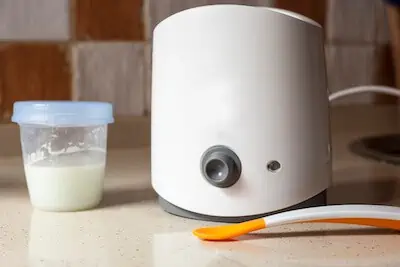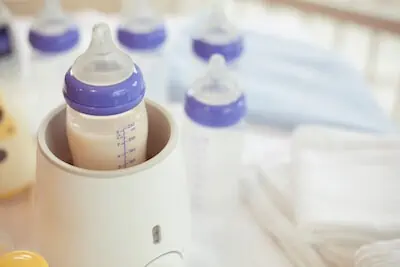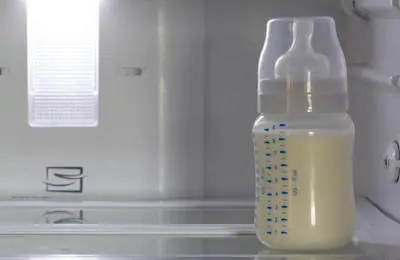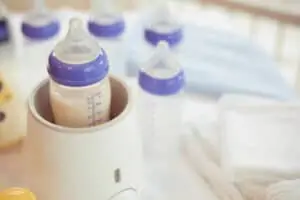Since my in-laws are Chinese, we have vast cultural differences. Because of this, we often had difficulty getting them to listen to us on food safety matters.
They’re good people but grew up in a totally different world. The world they grew up in was full of food shortages. They were grateful just to have rice to share.
When you look at things this way, you can begin to understand why my in-laws would not want to waste food, even in times of abundance.
I hate to waste things too, but you shouldn’t touch them when something has gone bad. Food safety becomes even more critical when you have kids. Right from the start, too.
Your milk can never go bad out of your breast, flowing into your baby’s mouth. Even expressing it and letting it sit out for a short bit (I’ll define that more specifically further down) is still fine.
But anything longer than that, you’ve got to refrigerate it. Or freeze it. And you need to contain it properly (I have a comprehensive post on all of that right here, so please check it out).
When my eldest didn’t want the fresh breast milk I’d left for her, I knew something was off. My husband asked his mother how long she’d let the milk sit out. Her answer?
She had it out all day!
She never bothered to store it.
She didn’t want to waste it either because, you know, food waste.
Thus, we had to show her why that was a bad idea and why the baby refused to eat it. We showed her how with some properly-stored breast milk, she was amazed that the baby happily gulped it down.
From then on, both my in-laws were on board with how to warm up breast milk and what to do with any that remains after feeding.
I know you are here to learn more about how long reheated breast milk is good for, whether you can put breast milk back in the fridge after warming, and if you can reheat breast milk that has already been heated, so let me get to that!
Can you reheat breastmilk twice?
Yes, you can safely reheat breastmilk a second time, but there are a couple of buts here. The first but is that you can only reheat it one additional time. I’d say that you’re destroying all those good nutrients every time you reheat it, so it’s probably not something you should often do.

Another thing to consider here is that reheating that same milk within a 4-hour period is best because the bacteria from your baby’s mouth also risk contaminating this milk.
Storing your freshly-expressed breast milk has more power to fight bacteria than any milk you have put in the refrigerator or freezer. Bacteria also grow more slowly than formula, so this one-off extra reheat of your breast milk is likely ok.
It would help if you also considered how clean all the equipment you used to pump. Suppose you can’t bank on it with confidence, or your in-laws are from the kind of cultural background where their idea of cleanliness is vastly different from your own. In that case, you may want to reconsider reheating any unused leftover breast milk.
Oh, and another thing…if your baby is sick, this exposure to what would otherwise be a normal amount of bacteria may make her feel worse. If it doesn’t, it will surely contaminate that milk for the next feeding, so get rid of it.
Can you reheat an unfinished bottle of breastmilk?
Unfortunately, there aren’t any studies about the safety of putting milk in the fridge after warming it or for those leaving it at room temperature. But knowing what we know about the refrigeration process, it does slow bacterial growth.
If you’re going to reheat that milk, give it a good sniff (read here to find out what normal smells are like), and if it smells ok, you can try it.
And now, we’ve arrived at the other BUT that I was leading up to earlier.

It’s what the doctors say, and the CDC advises – that if you have warmed the milk and fed your baby with it, the risk for contamination from bacteria is high. This is why the CDC staunchly states that if the baby didn’t drink all that breast milk, you could still use any that remains within 2 hours after the feeding but throw it away.
Due to the related evidence that exists, the Academy of Breastfeeding Medicine also advises that you discard that remaining milk once it has been 2 hours after the feeding. While you probably hate to waste things, and things will likely be ok, is it really a gamble you want to take?
To me, it’s far better to waste breast milk or formula to keep the baby healthy. Since there aren’t studies to provide an official confirmation, it’s ideal to avoid reheating the previously used milk. Don’t do it if the milk was frozen first and heated.
And whatever you decide, please, in the name of all that is holy, look for signs of spoilage before you serve milk the first time, let alone the second time. While reheating breast milk tends to get a thumbs-down the second time around, you may still be able to use that milk if it’s within 2 hours of that last feeding.
How long is warmed breast milk good for?
So, now you’ve got your breast milk and warmed it up. What do you do? Well, you should give it to your baby right away. Don’t leave warmed breast milk out for longer than 2 hours, and do not refreeze it. Just throw it away from there.
If you’re wondering when it’s just not ok to reheat that breastmilk, here’s a little checklist of when Leslie says DON’T REHEAT THE BREASTMILK if:
- It has been sitting out too long
- It smells foul
- Your baby is sick
- The milk was previously frozen
And here’s my GOLDEN RULES OF BREASTMILK:
- It’s good for up to 2 hours at room temperature
- No more than 8 days in the fridge
- Freeze for up to 6 months (as long as properly contained)

And now you’re likely wondering how you should store your milk for heating and reheating. The best thing you can do is start with a clean slate. Wash your hands and clean all the equipment you use. Then, express your milk.
Make sure you label your breast milk containers too. Look, we’re all tired. I had leftovers of food in the fridge recently that I couldn’t remember if they were from a couple of days ago or from the week before (yuck). Thankfully the kids remembered, though. But your baby can’t remind you, so take that worry off the table and label every container.
Don’t forget that you should always thaw any breast milk before heating it. Simply move it to the fridge the night before.
But Leslie, how do I heat up breast milk?
Good question! For starters, never do it in the microwave. It causes uneven heating and can even make it too hot and dangerous for the baby. It also degrades the milk’s proteins and nutrients, defeating its purpose.
Instead, you’ll want to warm water on the stovetop and put your breast milk container into that water. Please note that the water should be hot, but it should never be boiling.
And if you’re a mama using the formula, you may wonder if you can reheat that formula. I’m here to tell you NO. Please do not reheat the formula. It has a high chance of bacterial growth when you reheat it.
As for heating a refrigerated bottle with formula, you need to run it under hot water, then swirl it a little for a few minutes. You can also put the bottle in hot water until it reaches a desirable temperature. Like breast milk, never warm formula in the microwave.
Bottom line: really avoid reheating that breast milk more than once!
Leslie Berry lives with her husband and two young daughters in Los Altos, California, where she loves helping other moms get comfortable with motherhood and embracing the insanity with facts peppered with laughs.
She loves eating too much sushi, exercising, and jamming out on her Fender. Read more about Leslie here.





